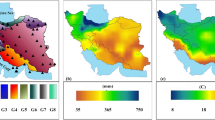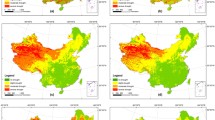Abstract
The droughts normally lead to devastating and long-lasting damage to agriculture, economy, and ecosystem, especially in Tibet Autonomous Region (hereafter Tibet) where ecosystem is fragile as a result of its special topographic, geomorphic, and climatic conditions. Due to limited observational data in this region, how often and where these droughts occur is not well understood. In this study, droughts intensity and frequency, as well as dryness condition over Tibet were assessed by using the Standardized Precipitation Evapotranspiration Index (SPEI) with meteorological data from 38 stations during period of 1971–2014. Temperature Vegetation Dryness Index (TVDI) was used to compared with SPEI based on observed drought area of Tibet. Moreover, the dryness condition was explained by the contribution of meteorological factors according to the method of contribution rate. Results indicated that dryness conditions were aggravating during the period 1971–2014 across Tibet. Besides, drought intensity and frequency presented considerable decadal variation over the past 44 years with more frequent moderate and severe drought occurring in period of 1981–1990 and 2001–2014 compared with other periods. This highlighted that Tibet has gone through serious drying in the 1970s and since 2000. Factor analysis indicated that precipitation played the most important role in the variation of SPEI-12M. Both drought indexes could effectively detect drought events over Tibet from 2001 to 2014. Investigating and evaluating drought characteristic, causes and drought indexes effectiveness provide essential information for balanced water resource allocation and utilization and drought prevention.










Similar content being viewed by others
References
Allen RG, Pereira LS, Raes D, Smith M (1998) Crop evapotranspiration-guidelines for computing crop water requirements-FAO Irrigation and drainage paper 56. FAO, Rome 300:D05109
Bao G, Liu Y, Liu N, Linderholm HW (2015) Drought variability in eastern Mongolian plateau and its linkages to the large-scale climate forcing. Clim Dyn 44:717–733
Beniston M, Stephenson DB (2004) Extreme climatic events and their evolution under changing climatic conditions. Glob Planet Chang 44:1–9
Bhalme HN, Mooley DA (1980) Large-scale droughts/floods and monsoon circulation. Mon Weather Rev 108:1197–1211
Bond NR, Lake PS, Arthington AH (2008) The impacts of drought on freshwater ecosystems: an Australian perspective. Hydrobiologia 600:3–16
Byun H-R, Wilhite DA (1996) Daily quantification of drought severity and duration. J Clim 5:1181–1201
Chen H, Sun J (2015) Changes in drought characteristics over China using the standardized precipitation evapotranspiration index. J Clim 28:5430–5447
Chunqiao S, Songcai YOU, Gaohuan LIU et al (2011) The spatial pattern of soil moisture in Northern Tibet based on TVDI method. Prog Geogr 30:569–576
Clow DW (2010) Changes in the timing of snowmelt and streamflow in Colorado: a response to recent warming. J Clim 23:2293–2306
Dai A (2013) Increasing drought under global warming in observations and models. Nat Clim Chang 3:52–58
Das PK, Dutta D, Sharma JR, Dadhwal VK (2016) Trends and behaviour of meteorological drought (1901–2008) over Indian region using standardized precipitation–evapotranspiration index. Int J Climatol 36:909–916
Deng Y, Gou X, Gao L, Yang M, Zhang F (2017) Spatiotemporal drought variability of the eastern Tibetan plateau during the last millennium. Clim Dyn 49:2077–2091
Dhorde AG, Patel NR (2016) Spatio-temporal variation in terminal drought over western India using dryness index derived from long-term MODIS data. Ecol Inform 32:28–38
Dombrovskiy VY, Martin AA, Sunderram J, Paz HL (2007) Rapid increase in hospitalization and mortality rates for severe sepsis in the United States: a trend analysis from 1993 to 2003. Crit Care Med 35:1244–1250
Freedman DA (2005) Statistical models: theory and practice. Cambridge University Press, Cambridge
Gao Z, Gao W, Chang N-B (2011) Integrating temperature vegetation dryness index (TVDI) and regional water stress index (RWSI) for drought assessment with the aid of LANDSAT TM/ETM+ images. Int J Appl Earth Obs Geoinf 13:495–503
Hao Z, Singh VP (2015) Drought characterization from a multivariate perspective: a review. J Hydrol 527:668–678
Hayes M, Svoboda M, Wall N, Widhalm M (2011) The Lincoln declaration on drought indices: universal meteorological drought index recommended. Bull Am Meteorol Soc 92:485–488
He B, Lü A, Wu J, Zhao L, Liu M (2011) Drought hazard assessment and spatial characteristics analysis in China. J Geogr Sci 21:235–249
Hernandez EA, Uddameri V (2014) Standardized precipitation evaporation index (SPEI)-based drought assessment in semi-arid South Texas. Environ Earth Sci 71:2491–2501
Herrera-Estrada JE, Satoh Y, Sheffield J (2017) Spatiotemporal dynamics of global drought. Geophys Res Lett 44:2254–2263
Islam SU, Déry SJ, Werner AT (2017) Future climate change impacts on snow and water resources of the Fraser River Basin, British Columbia. J Hydrometeorol 18:473–496
Kogan FN (1995) Application of vegetation index and brightness temperature for drought detection. Adv Space Res 15:91–100
Li Z, Chen Y, Yang J, Wang Y (2014) Potential evapotranspiration and its attribution over the past 50 years in the arid region of Northwest China. Hydrol Process 28:1025–1031
Li B, Zhou W, Zhao Y, Ju Q, Yu Z, Liang Z, Acharya K (2015) Using the SPEI to assess recent climate change in the Yarlung Zangbo River basin, South Tibet. Water 7:5474–5486
Li D, Wrzesien ML, Durand M et al (2017a) How much runoff originates as snow in the western United States, and how will that change in the future? Geophys Res Lett 44(12):6163–6172
Li Y, Chen C, Sun C (2017b) Drought severity and change in Xinjiang, China, over 1961–2013. Hydrol Res 48:1343–1362
Liang L, Zhao S, Qin Z et al (2014) Drought change trend using MODIS TVDI and its relationship with climate factors in China from 2001 to 2010. J Integr Agric 13:1501–1508
Lou W, Wu L, Mao Y, Sun K (2018) Precipitation and temperature trends and dryness/wetness pattern during 1971–2015 in Zhejiang Province, southeastern China. Theor Appl Climatol 133:47–57
McCabe GJ, Clark MP (2005) Trends and variability in snowmelt runoff in the western United States. J Hydrometeorol 6:476–482
McKee TB, Doesken NJ, Kleist J (1993) The relationship of drought frequency and duration to time scales. In: Proceedings of the 8th conference on applied climatology. American Meteorological Society, Boston, pp 179–183
Mei X, Zhu Q, Ma L, Zhang D, Liu H, Xue M (2018) The spatial variability of soil water storage and its controlling factors during dry and wet periods on loess hillslopes. CATENA 162:333–344
Mishra AK, Singh VP (2010) A review of drought concepts. J Hydrol 391:202–216
Mishra AK, Singh VP (2011) Drought modeling—a review. J Hydrol 403:157–175
Moore JN, Harper JT, Greenwood MC (2007) Significance of trends toward earlier snowmelt runoff, Columbia and Missouri Basin headwaters, western United States. Geophys Res Lett 34
Morid S, Smakhtin V, Moghaddasi M (2006) Comparison of seven meteorological indices for drought monitoring in Iran. Int J Climatol J R Meteorol Soc 26:971–985
Palmer WC (1968) Keeping track of crop moisture conditions, nationwide: the new crop moisture index
Patel NR, Chopra P, Dadhwal VK (2007) Analyzing spatial patterns of meteorological drought using standardized precipitation index. Meteorol Appl 14:329–336
Piao S, Ciais P, Huang Y, Shen Z, Peng S, Li J, Zhou L, Liu H, Ma Y, Ding Y, Friedlingstein P, Liu C, Tan K, Yu Y, Zhang T, Fang J (2010) The impacts of climate change on water resources and agriculture in China. Nature 467:43–51
Palmer WC (1965) Meteorological drought. Research Paper No. 45. US Department of Commerce, Washington. Weather Bureau, pp 59
Rosenzweig C, Iglesias A, Yang X et al (2001) Climate change and extreme weather events; implications for food production, plant diseases, and pests. Glob Change Hum Health 2:90–104
Roundy JK, Ferguson CR, Wood EF (2013) Temporal variability of land–atmosphere coupling and its implications for drought over the Southeast United States. J Hydrometeorol 14:622–635
Sandholt I, Rasmussen K, Andersen J (2002) A simple interpretation of the surface temperature/vegetation index space for assessment of surface moisture status. Remote Sens Environ 79:213–224
Song QH, Zhang YP, Tan ZH, Zhang LM, Yang Z, Zhao SJ, Sun XM (2010) Net photosynthesis and its affecting factors in a tropical seasonal rainforest ecosystem in Southwest China. Ying Yong Sheng Tai Xue Bao. J Appl Ecol 21:3007–3014
Thomas J, Prasannakumar V (2016) Temporal analysis of rainfall (1871–2012) and drought characteristics over a tropical monsoon-dominated state (Kerala) of India. J Hydrol 534:266–280
Tian L, Yao T, Schuster P et al (2003) Oxygen-18 concentrations in recent precipitation and ice cores on the Tibetan Plateau. J Geophys Res: Atmos 108.D9
Trenberth KE (2011) Changes in precipitation with climate change. Clim Res 47:123–138
Van Rooy M (1965) A rainfall anomaly index independent of time and space. Notos 14:6
Vicente-Serrano SM, Beguería S, López-Moreno JI (2010) A multiscalar drought index sensitive to global warming: the standardized precipitation evapotranspiration index. J Clim 23:1696–1718
Vicente-Serrano SM, Beguería S, Lorenzo-Lacruz J, Camarero JJ, López-Moreno JI, Azorin-Molina C, Revuelto J, Morán-Tejeda E, Sanchez-Lorenzo A (2012) Performance of drought indices for ecological, agricultural, and hydrological applications. Earth Interact 16:1–27
Wang C, Qi S, Niu Z, Wang J (2004) Evaluating soil moisture status in China using the temperature–vegetation dryness index (TVDI). Can J Remote Sens 30:671–679
Wang L, Chen W, Zhou W (2014) Assessment of future drought in Southwest China based on CMIP5 multimodel projections. Adv Atmos Sci 31:1035–1050
Wang Q, Shi P, Lei T, Geng G, Liu J, Mo X, Li X, Zhou H, Wu J (2015) The alleviating trend of drought in the Huang-Huai-Hai Plain of China based on the daily SPEI. Int J Climatol 35:3760–3769
Wang Z, Li J, Lai C, Zeng Z, Zhong R, Chen X, Zhou X, Wang M (2017) Does drought in China show a significant decreasing trend from 1961 to 2009? Sci Total Environ 579:314–324
Wells N (2003) PDSI users manual version 2.0. Natl Agric Decis support Syst Univ Nebraska–Lincoln
Wilhite DA (2000) Chapter 1 Drought as a natural hazard: concepts and definitions. Drought mitigation Center Faculty Publications pp 69
Wilhite DA, Glantz MH (1985) Understanding: the drought phenomenon: the role of definitions. Water Int 10:111–120
Wu H, Hayes MJ, Weiss A, Hu Q (2001) An evaluation of the standardized precipitation Index, the China-Z Index and the statistical Z-Score. Int J Climatol 21:745–758
Wu J, Zhao Y, Yu C, Luo L, Pan Y (2017) Land management influences trade-offs and the total supply of ecosystem services in alpine grassland in Tibet, China. J Environ Manag 193:70–78
Xu ZX, Gong TL, Li JY (2008) Decadal trend of climate in the Tibetan Plateau—regional temperature and precipitation. Hydrol Process 22:3056–3065
Xu Y, Xu Y, Wang Y, Wu L, Li G, Song S (2017) Spatial and temporal trends of reference crop evapotranspiration and its influential variables in Yangtze River Delta, eastern China. Theor Appl Climatol 130:945–958
Yan Z, Zhang Y, Zhou Z, Han N (2017) The spatio-temporal variability of droughts using the standardized precipitation index in Yunnan, China. Nat Hazards 88:1023–1042
Yan-fei B, Jian-jun B, Yong-lin L (2016) The spatial-temporal variations of spring drought in Hebei Province based on TVDI and meteorological drought index. J Lanzhou Univ Nat Sci 2:006
Zhang Y, Liu C, Tang Y, Yang Y (2007) Trends in pan evaporation and reference and actual evapotranspiration across the Tibetan Plateau. J Geophys Res: Atmos 112(D12)
Zhang L, Jiao W, Zhang H, Huang C, Tong Q (2017) Studying drought phenomena in the continental United States in 2011 and 2012 using various drought indices. Remote Sens Environ 190:96–106
Zhao Y-Z, Zou X-Y, Cheng H, Jia HK, Wu YQ, Wang GY, Zhang CL, Gao SY (2006) Assessing the ecological security of the Tibetan plateau: methodology and a case study for Lhaze County. J Environ Manag 80:120–131
Funding
This work was funded by the National Nature Science Foundation of China (Nos. 41371058, 41571027, and 41601021).
Author information
Authors and Affiliations
Corresponding author
Additional information
Publisher’s note
Springer Nature remains neutral with regard to jurisdictional claims in published maps and institutional affiliations.
Rights and permissions
About this article
Cite this article
Li, S., Yao, Z., Liu, Z. et al. The spatio-temporal characteristics of drought across Tibet, China: derived from meteorological and agricultural drought indexes. Theor Appl Climatol 137, 2409–2424 (2019). https://doi.org/10.1007/s00704-018-2733-9
Received:
Accepted:
Published:
Issue Date:
DOI: https://doi.org/10.1007/s00704-018-2733-9




